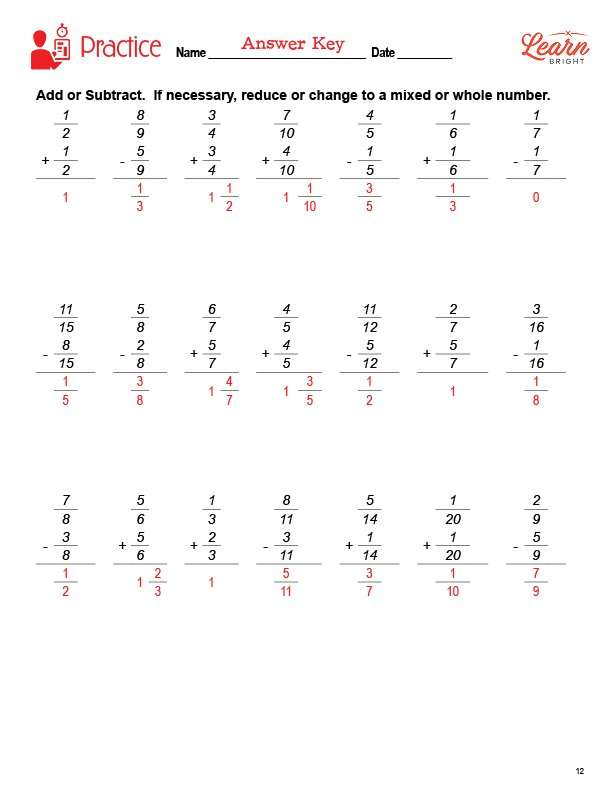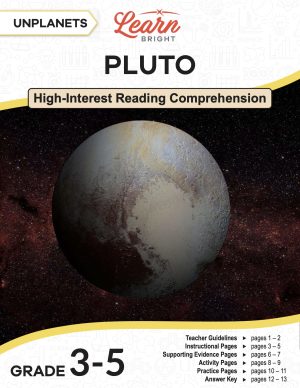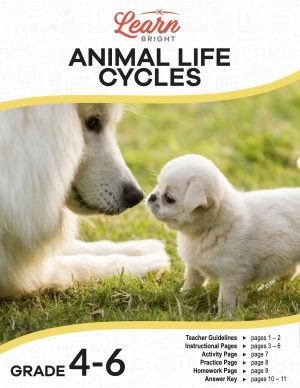Description
What our Fractions: Add and Subtract Like Denominators lesson plan includes
Lesson Objectives and Overview: Fractions: Add and Subtract Like Denominators equips students to add and subtract fractions with like denominators. Leverage creativity and collaborative learning as student pairs compose drawings to share with other groups. A class survey provides the opportunity for meaningful application of fractions to the survey results. At the end of the lesson, students will be able to add and subtract fractions with like denominators. This lesson is for students in 4th grade, 5th grade, and 6th grade.
Classroom Procedure
Every lesson plan provides you with a classroom procedure page that outlines a step-by-step guide to follow. You do not have to follow the guide exactly. The guide helps you organize the lesson and details when to hand out worksheets. It also lists information in the blue box that you might find useful. You will find the lesson objectives, state standards, and number of class sessions the lesson should take to complete in this area. In addition, it describes the supplies you will need as well as what and how you need to prepare beforehand.
Options for Lesson
Included with this lesson is an “Options for Lesson” section that lists a number of suggestions for activities to add to the lesson or substitutions for the ones already in the lesson. One optional addition to the lesson activity is to have your students create a word problem for each fraction sentence. During the lesson, you could use hands-on manipulatives to help your students better understand adding and subtracting fractions. You could also use the practice and homework pages for a quiz or short test. Finally, you could use items in the classroom, or take students outdoors, to create word problems for adding and subtracting fractions.
Teacher Notes
The teacher notes page includes a paragraph with additional guidelines and things to think about as you begin to plan your lesson. This page also includes lines that you can use to add your own notes as you’re preparing for this lesson.
FRACTIONS: ADD AND SUBTRACT LIKE DENOMINATORS LESSON PLAN CONTENT PAGES
What is a Fraction?
The Fractions: Add and Subtract Like Denominators lesson plan includes three content pages. If you start to eat a bag of chips but don’t finish it, you’ve eaten a fraction of the chips. Fractions are parts of a whole, and everything can be divided into fractional parts. To visualize this, the lesson shows four circles, three of which are shaded blue. This means that 3/4 of the circles are blue.
Say you have two pizzas in front of you, one cheese and one pepperoni. You may eat three pieces of pepperoni pizza and two pieces of cheese pizza. All in all, you ate 5 pieces of pizza. However, if you want to figure out what fraction of a whole pizza you’ve eaten, you’ll need to add fractions.
The top number of a fraction is the numerator and the bottom number is the denominator. The numerator represents part of the whole, and the denominator represents the whole.
Addition & Subtraction of Like-Denominator Fractions
Adding and subtracting fractions is easy, especially when the fractions have the same denominator. To add fractions with like denominators, you just need to keep the denominator as-is and add the numerators together. For example, 2/5 + 1/5 = 3/5.
Sometimes, you will need to either reduce the fraction or change it to a mixed or whole number. Students should already have this skill and should be able to recognize when they need to reduce or convert their fractions. The lesson includes a few examples as a review.
Like with addition, to subtract fractions with like denominators, you keep the denominator the same. You then subtract the numerators. For example, 4/7 – 2/7 = 2/7.
Again, you might need to reduce or change the fractions when subtracting. The lesson includes a few examples for review.
Solving Fraction Word Problems
When solving word problems with fractions, the most important thing is to read them carefully. Identify the key words that indicate fractions, such as a part of, cut, pieces, and more. Next, identify the key words that tell you which operation or operations you will need to use, addition (in all, total, sum, etc.) or subtraction (difference, left over, more than, etc.).
The lesson closes with an example fraction word problem. In this problem, Kate ate 5 pieces of a 12-piece pepperoni pizza and 1 piece of a 12-piece cheese pizza. To figure out how much pizza she ate in total, you need to add fractions. Because the pizzas have 12 pieces, the denominator is 12. 5 and 1 are the numerators because they represent part of the whole. To solve, we add the fractions and then reduce: 5/12 + 1/12 = 6/12 = 1/2. All in all, Kate ate 1/2 of a pizza.
FRACTIONS: ADD AND SUBTRACT LIKE DENOMINATORS LESSON PLAN WORKSHEETS
The Fractions: Add and Subtract Like Denominators lesson plan includes three worksheets: an activity worksheet, a practice worksheet, and a homework assignment. You can refer to the guide on the classroom procedure page to determine when to hand out each worksheet.
PICTURE ACTIVITY WORKSHEET
The activity worksheet asks students to draw pictures showing how to solve each of the given problems, using both groups and wholes. If they need to reduce or change to a mixed or whole number, they will show that with a picture as well.
ADD OR SUBTRACT PRACTICE WORKSHEET
For the practice worksheet, students will solve each fraction problem by adding or subtracting. They will also reduce each fraction or change them to a mixed or whole number if needed.
FRACTIONS: ADD AND SUBTRACT LIKE DENOMINATORS HOMEWORK ASSIGNMENT
The homework assignment asks students to solve four fraction word problems, reducing or changing their answer to a mixer or whole number if needed.
Worksheet Answer Keys
This lesson plan includes answer keys for the activity worksheet, the practice worksheet, and the homework assignment. If you choose to administer the lesson pages to your students via PDF, you will need to save a new file that omits these pages. Otherwise, you can simply print out the applicable pages and keep these as reference for yourself when grading assignments.









